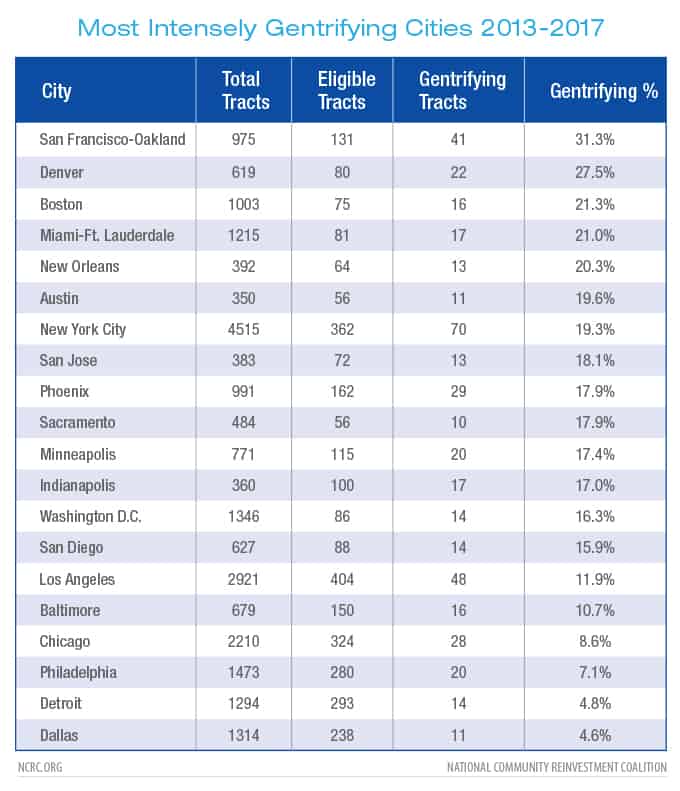San Francisco was the most intensely gentrified city in America from 2013 to 2017, a new study found.
It was followed by Denver, Boston, Miami and New Orleans. They had the largest share of their vulnerable neighborhoods that gentrified during that time period.
The study, from the National Community Reinvestment Coalition, is a follow-up to the organization’s 2019 gentrification and displacement rankings, in which Washington, DC, was the most gentrified city in the nation from 2000-2013. In the 2020 report, DC dropped to No. 13. Gentrification continued there, but it surged elsewhere.
NCRC identified 954 neighborhoods with indications of gentrification in the period 2013-2017. The vast majority of these neighborhoods came from just 20 cities, where each had at least ten neighborhoods gentrified during the 2013-2017 period. Nationally, half of all of the gentrifying neighborhoods were in these 20 cities.

NCRC once again found that gentrification remained a significant threat to minority and LMI families in some of the largest and most prosperous parts of the country. These cities are home to over 14% of all Americans.
Cultural displacement, the process where gentrification encourages a change in the social and racial composition of the population, is likely occurring in these communities as well. The 2020 U.S. Census will allow NCRC to measure this displacement. That data is expected to be available by 2022.
Throughout the rest of the country the community and personal challenges of chronic disinvestment and poverty, rather than growth and displacement, was common throughout nearly all LMI neighborhoods. In most of the country, high levels of inequality as well as low home values and incomes prevented families from building wealth at all.
“Some cities were booming, and that created unique and difficult challenges for longtime residents who were priced out and pushed out, but in most of the country, lower-income residents and neighborhoods suffered from a lack of investment, stagnant economies and fewer opportunities to accumulate personal wealth,” said Jason Richardson, NCRC director of research and evaluation, and one of the lead authors of the report.
The study also investigated the newly-created Opportunity Zones (OZs), where the 2017 tax overhaul offered investors new tax breaks. Opportunity Zones allow investors that have capital gains earned from the sale of other property and assets to invest them and avoid some or all of the tax due on them. NCRC found that neighborhoods designated as OZs were indeed the places in the most dire need of investment. Perhaps not surprising, there was a close association between neighborhoods that gentrified and where OZs were located. Sixty-nine percent of neighborhoods experiencing gentrification from 2013-2017 were either in or adjacent to an OZ. Overall though, neighborhoods designated as OZs far outnumbered those neighborhoods where gentrification was found.
As of now, so little is known about investment in Opportunity Zones that it is difficult to tell what impact, if any, they are having on the areas included in this study. A general lack of transparency permeates the Opportunity Zone program.
“We cannot tell who is investing, where the money is going or what kinds of projects are being funded. Four months into the COVID-19 pandemic, we can assume that many of the capital gains that investors would have invested there might not exist. In that case, the question has shifted from ‘who is investing in Opportunity Zones?’ to a more fundamental ‘who has anything to invest in Opportunity Zones?’” Richardson said.


